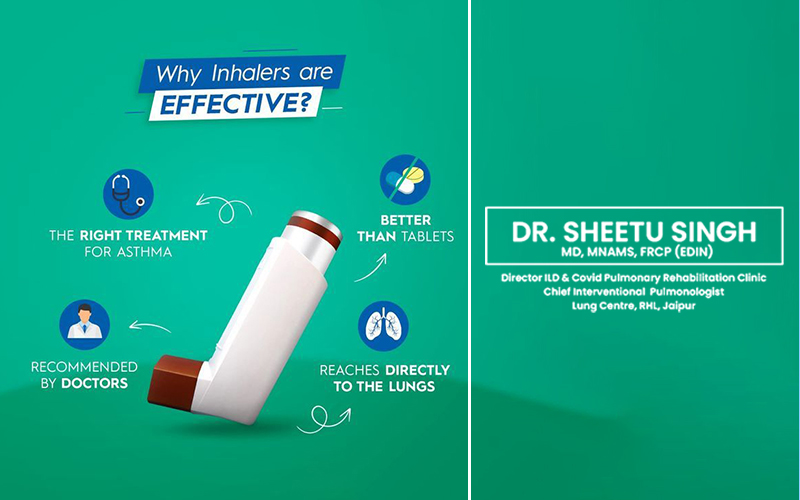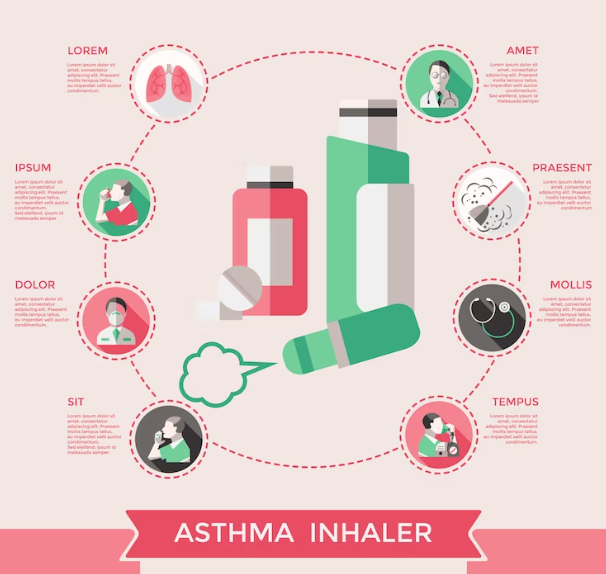Chronic Obstructive Pulmonary disease (COPD) is a common lung condition. It affects over 6% of the population in the United States, where smoking is the leading cause of COPD. Symptoms of COPD include cough, chest infections, and breathlessness. It may also affect mood, quality of life, and life expectancy. The primary treatment for COPD is inhalers. These are drugs that are inhaled into the lungs. COPD inhalers are available in a wide variety of sizes and forms. They vary in cost and type of medication and device. Selecting the inhalers that best suit your needs, your way of life, and your budget might be difficult with so many variations available. Consulting with Dr. Sheetu Singh for a Guide to COPD inhalers promises an insightful and comprehensive understanding of managing Chronic Obstructive Pulmonary Disease (COPD). By seeking counsel from Dr. Sheetu Singh, individuals with COPD gain not only a reliable source of medical expertise but also a compassionate partner in their journey toward better respiratory health.
Inhalers and COPD: The Basics
We need to go over some fundamentals regarding what happens to the lungs in COPD before we can comprehend how inhalers help. COPD stands for “chronic obstructive pulmonary disease.:
- Chronic: This implies that there is no treatment for the illness, making it a permanent condition.
- Obstructive: This describes how the lungs’ airways are obstructed, making it difficult for the lungs to pump air into and out of the body.
- Pulmonary: This refers to the airways.
People with COPD typically have two lung problems:
- Emphysema: This is harm to the lungs’ air sacs, or alveoli, typically brought on by smoking cigarettes. The main symptom is breathlessness.
- Chronic Bronchitis: This is another example of lung airway impairment brought on mostly by cigarette smoking. This inflammation causes mucus, cough, and frequent chest infections.
What is an Inhaler, and how does it work?
The most popular method of taking COPD medication is with an inhaler. When an inhaler is used correctly, the drug enters the lungs, where it is needed. Nebulizers and spacers are two further tools that can be useful (more on those later). We will go through each of the several varieties of inhalers in this guide. Inhalers for COPD vary by:
- Medication: They contain different active ingredients.
- Dosage: Every puff delivers a different dose.
- Device: Inhalers work in different ways.
- Affordability: Generic alternatives vary in price and availability.
Types of Inhalers for Treating COPD
COPD inhalers can be categorized based on two factors: the kind of device and the medication it contains.
1. Types of COPD Inhaler Medications
An inhaler may be referred to as a “preventer” or “reliever” by your provider. These phrases describe the kind of drug that is contained in the inhaler:
- Preventer (maintenance) Inhaler: A COPD preventer inhaler aids in preventing the disease’s symptoms and flare-ups. This kind of medication is used once or twice a day, with each dose taken at the same time.
- Reliever (Rescue) Inhaler: A reliever inhaler offers immediate relief from symptoms. Reliever inhalers can be used occasionally or not at all. The frequency of usage is contingent upon one’s symptoms.
2. Types of COPD Inhaler Devices
Different devices use different methods to get medication into the lungs. You can choose between:
- Metered Dose Inhalers (MDIs): MDIs contain medication in a liquid form. Like a spray can, the inhaler releases the liquid medication as an Aerosol. You must take a deep breath in while utilizing an MDI, precisely when you press the button on the device. The timing of this can be tricky for some people.
- Dry Powder Inhalers (DPIs): DPIs contain medication in dry powder form. A capsule holding powder is punctured by the inhaler mechanism. The powder is then directly inhaled through the lips into the lungs. As you don’t have to time your inhalation with button pressing, DPIs may be simpler to use for certain individuals. However, it requires deep breathing to be effective.
Both MDIs and DPIs can deliver both types of medication (relievers and preventers).
3. Nebulizers
Medication for COPD may also be used as a nebulizer. A nebulizer is a device that uses a mask to create a mist that you can inhale into your lungs instead of a liquid medication. Nebulizers can be easier to use for some people. For instance, they’re frequently applied in hospitals for severely dyspeptic patients. Nebulizers can be used at home by certain persons daily or in an emergency, depending on their needs.
4. Bronchodilators
Pharmacological agents known as bronchodilators facilitate airway opening by causing the surrounding muscles to relax. The bronchodilator medications used in COPD inhalers are beta-agonists and Antimuscarinics. These drugs may have a short or extended half-life and be used to treat symptoms over time or to relieve them immediately:
- Short-acting beta Agonists (SABAs)
- Long-acting beta Agonists (LABAs)
- Short-acting Muscarinic Antagonists (SAMAs)
- Long-acting Muscarinic Antagonists (LAMAs)
Short-acting Beta Agonists (SABAs)
Breathing becomes easier and the airways become more relaxed and expansive when SABAs act on the beta-2 receptors in the lungs. An often-used bronchodilator inhaler is SABA. They can be purchased as nebulizer solutions, DPIs, and MDIs.
Regardless of symptoms, SABAs are not the kind of inhaler you use every day. Usually, you’ll utilize it when your symptoms get worse. This is because, while they act fast, the relief they provide is just momentary. In hospitals, they are frequently administered via nebulizers. Common examples include:
- Albuterol (ProAir, Accuneb, Proventil, Ventolin HFA)
- Levalbuterol (Xopenex HFA)
Precautions
If you need to take your SABA more frequently than once every four hours, either because your symptoms are returning or the inhaler is not functioning as it should, give your healthcare practitioner a call straight away. If you take these drugs more frequently than once every four hours, you may be extremely ill and require immediate medical attention. This inhaler can cause shaking of the hands (Tremors), noticeable heartbeats (Palpitations), or feelings of excitement or stress.
Long-acting Beta Agonist (LABA)
Like SABAs, LABAs also help open the airways by relaxing the muscles around them. The distinction is that LABAs operate for a greater amount of time than SABAs. LABAs are one of the primary COPD therapies. LABAs are long-acting drugs that are given once or twice daily to either stop symptoms altogether or to stabilize them. They’re available as DPIs, MDIs, and other Nebulizer solutions. Common examples include:
- Salmeterol (Serevent Diskus)
- Formoterol (Perforomist)
- Arformoterol (Brovana)
- Olodaterol (Striverdi Respimat)
Precautions
Tremors (handshaking), palpitations (noticeable heartbeats), and anxiety or excitement are all possible side effects of LABAs.
Short-acting Muscarinic Antagonists (SAMAs)
Similar to SABAs, SAMAs facilitate breathing by acting on receptors in the lungs. One such is Ipratropium (Atrovent).
Short-acting, low-cost SAMAs have the potential to alleviate dyspnea symptoms, particularly when combined with a SABA. SAMAs are typically used in conjunction with inhalers rather than alone. Additionally, if you currently take LAMA daily, you shouldn’t use them. They can be purchased as MDIs, and hospitals also utilize them in nebulizers.
Precautions
It is advisable to see a healthcare provider if your inhaler is not providing relief from your symptoms or if you are using it more frequently than once every six hours.
Long-acting Muscarinic Antagonista (LAMAs)
These medications help to ease symptoms for a longer period because they are long-acting SAMAs. LAMAs are daily long-acting medicines used to either prevent or stabilize symptoms. They’re available as DPIs, MDIs, and nebulizer solutions. Examples include:
- Tiotropium (Spiriva Handihaler, Spiriva Respimat)
- Umeclidinium (Incruse Ellipta)
- Aclidinium (Tudorza Pressair)
- glycopy rrolate (Lonhala Magnair)
- Revefenacin (Yupelri)
Precautions
LAMAs can cause a dry mouth.
Inhaled Corticosteroids
Inhaled Corticosteroids are medications that assist in lessening airway inflammation, which facilitates breathing. These should only be used to treat COPD in patients who, despite taking a LABA, LAMA, or both, are still experiencing symptoms. Stated differently, patients with more severe forms of COPD are treated with inhaled corticosteroids.
It is recommended to use inhaled corticosteroids in conjunction with a LABA and/or LAMA, either as a separate inhaler or as part of a combination Inhaler. That’s because Bronchodilators work better for treating COPD- with fewer side effects than steroids. Inhaled Corticosteroids are available as MDIs and DPIs on their own. Example include:
- Budesonide (Pulmicort)
- Fluticasone (Flovent, ArmonAir Digihaler, Arnuity Ellipta)
- Mometasone (Asmanex HFA, Asmanex Twisthaler)
Precautions
You can prevent side effects such as voice changes and fungal infections in the mouth by using these inhalers with a spacer and carefully cleaning your mouth afterward (Oral Thrush).
Combination Inhalers
Your provider may prescribe you a combination Inhaler. This is an inhaler that combines two (or often three) distinct medications. When you take both medicines at once, the relief from dyspnea is greater than when you take them separately.
Combination inhalers, which facilitate the simultaneous administration of various medications, are frequently prescribed to patients with more severe cases of COPD.
Long-acting Bronchodilators (LABA+LAMA)
The most typical pairing Two long-acting bronchodilators are included in COPD inhalers (LABA+LAMA):
- umeclidinium/Vilanterol (Anoro Ellipta)
- Tiotropium/Olodaterol (Stiolto Respimat)
- Glycopyrrolate/Formoterol (Bevespi Aerosphere)
- Aclidinium/Formoterol (Duaklir Pressair)
Short-acting Bronchodilator (LABA OR LAMA) with a Corticosteroid
Additionally, a corticosteroid and a long-acting bronchodilator (LABA or LAMA) can be obtained together:
- Fluticasone/Salmeterol (Advair Diskus, Wixela Inhub)
- Budesonide/Formoterol (Symbicort)
- Fluticasone/Vilanterol (Breo Ellipta)
- Mometasone/Formoterol (Dulera)
Three-Ingredient Inhaler (LABA-LAMA+Corticosteroid)
LABA, LAMA, and corticosteroids are the three constituents of one kind of inhaler. As an illustration, consider:
- Trelegy Ellipta (Fluticasone/Umeclidinium/Vilanterol)


